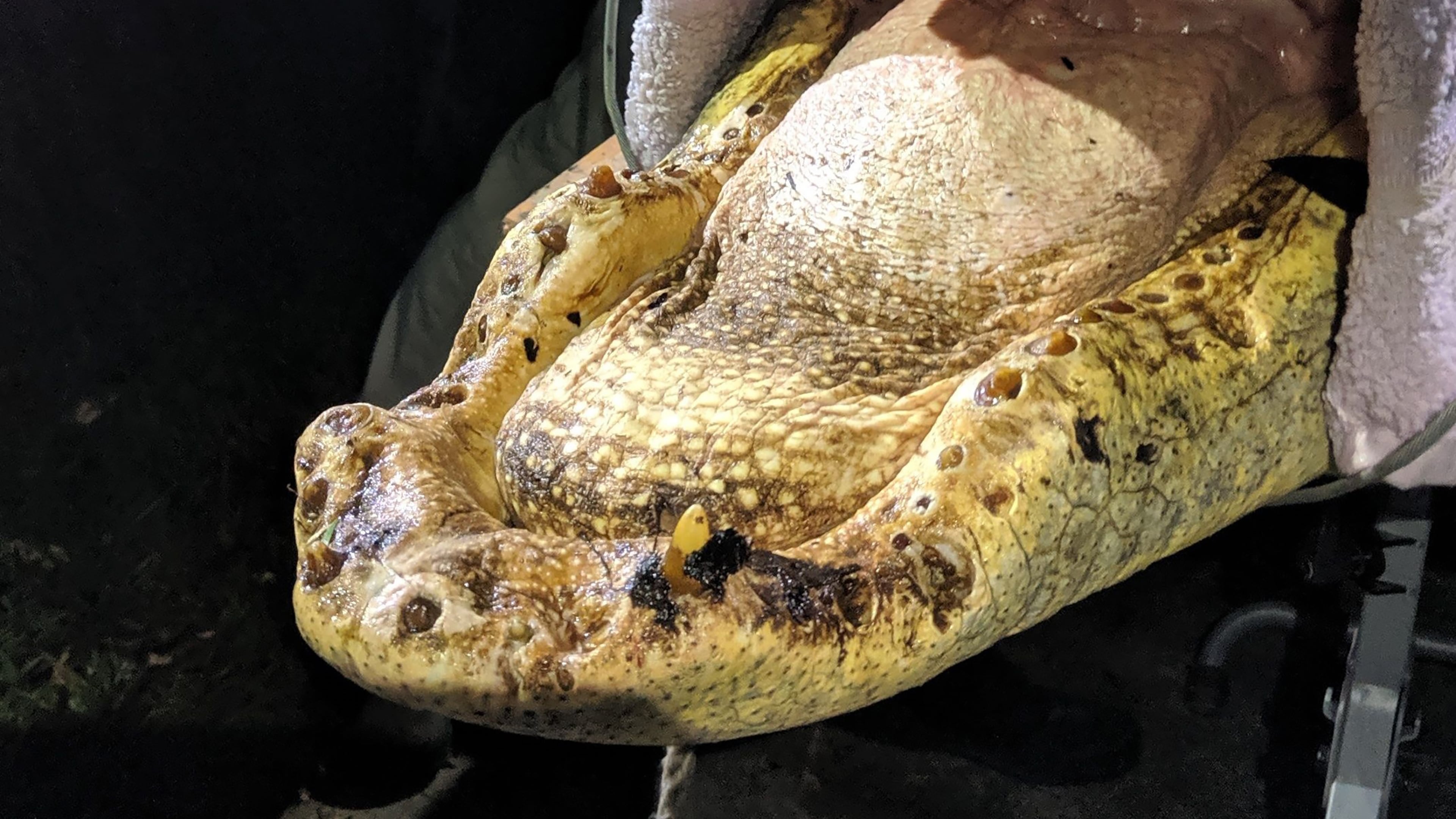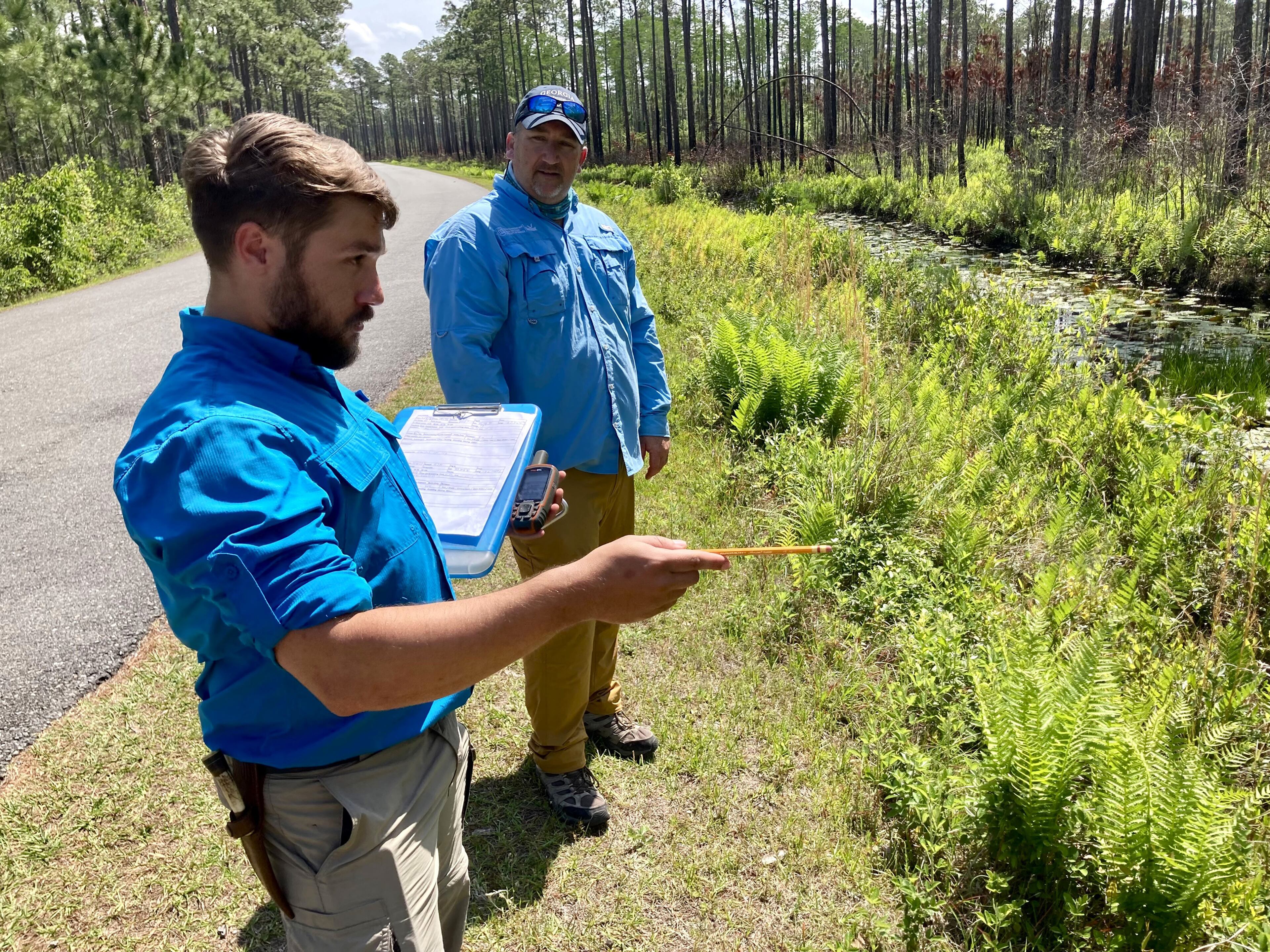Out of the murky waters of the Okefenokee, an alligator mystery emerges

FOLKSTON — A question is gnawing at the researchers who ply the waters of the Okefenokee Swamp:
Why are some alligators there losing their teeth?
This is a mystery that has confounded scientists for several years. They aren’t aware of the phenomenon happening anywhere else.
Alligator mississippiensis is renowned for its big choppers. A grown gator usually has about 80 teeth, ranging from little bumpy biters to dagger-sized slashers. Because it can regenerate a lost tooth, an alligator may go through more than 2,000 in its lifetime.
That is, unless that gator happens to live in the dark waters of the sprawling swamp on the Georgia-Florida line, 4½ hours south of Atlanta.
In the Okefenokee, some of these reptiles are not only missing teeth. Others have teeth that are so brown-stained that it looks as if they’ve been chewing tobacco.
“The animals are otherwise very healthy,” said Kimberly M. Andrews, a coastal ecology specialist who heads the University of Georgia’s Marine Extension and Georgia Sea Grant Program. The irregularities occur among gators of all sizes and ages, she added.

Like any scientist, Andrews is reluctant to speculate why some gators lose teeth while others retain a full array of choppers, or why some have teeth the color of weak coffee. But some experts have theorized that the stains might be caused by tannins, created by rotting vegetation, leaves and trees in the water.
“If you sat in that water for a long time, you’d be discolored, too,” said Perran Ross, a retired professor of conservation biology at the University of Florida.
Andrews thinks the answer might be more complicated.
“Like all things in ecology, a lot of factors could play into this,” said Andrews. It may be diet that has caused teeth to fall out. Just as the swamp’s murky water may be a reason for the dark teeth. Or maybe it’s something else.
While some gators, like humans, may lose their teeth as the years pass, researchers aren’t ready to say that old age is the cause of the dental problems.
The mystery of the missing teeth has become part of a larger study of Okefenokee gators. For six years, they’ve been keeping track of gators – their habits, their habitats and their teeth.
The research, said Andrews, is necessary to help understand and protect alligators.
Gators galore
In the Okefenokee National Wildlife Refuge, a 24-foot Carolina skiff carried two of those researchers over cola-colored water, its 9.9-hp Honda outboard purring. Sawgrass palmettos waved as they passed.

Mark Hoog, a Georgia Southern University graduate student studying gators for his master’s thesis, pointed to his left. “There’s one.”
A gator’s eyes poked out of the water. They looked like black ball bearings.
“There’s one,” said Bryan Fleuch, associate director of UGA’s Marine Extension and program.
Hoog: “Another one.”
Gators were everywhere. Some peered from sloughs in a canal built more than a century ago by men and steam shovels to serve the logging industry. Others swam in the 5- to 6-foot depths, their tails weaving S-shaped wakes. Just as many sunned themselves on logs.
Hoog had a log, too, a clipboard with papers detailing the lives and locations of seven gators. They are among 21 Okefenokee swimmers outfitted with satellite transmitters. The devices allow Hoog to track them in the swamp’s waterways and hammocks. Those seven are among 290 gators under study. The majority are identified the old-fashioned way, with markings along scutes, the bony plates on their tails. A select few have the high-tech gadgets just behind their heads.
He set aside about four hours one recent morning to track the movements of the seven. Ideally, said Hoog, he’d get a reading as well as get a good look at each.
“I spend an unusual amount of time looking at gators,” he said.
Hoog’s study focuses on three areas: gators’ health, genetics, and their movement/behavior. While gator teeth aren’t a formal topic of his inquiries, he’s keeping track of his subjects’ dental health, too. He notes the condition of their teeth from good, meaning all choppers in place, “with pearly whites,” to poor, meaning no teeth or just a few, with stains.
Hoog is the second grad student to ponder the alligators’ dental condition since the research began in 2017.
The boat slowed as it approached a spot where one of his alligators was known to hang out. Hoog assembled his tracking device. It looked like an old TV antenna from your grandmother’s roof.
Fluech throttled back until the boat was almost dead in the water. Hoog stepped to the bow. In one hand he held the antenna; in the other, a radio transmitter. He turned a knob. Static greeted him.
Then – beep! The alligator, no doubt about it. “He’s probably five, 10 meters from where we are,” Hoog said.
He moved from one side of the bow to the other, swinging the antenna. He was rewarded with a few more beeps, but no gator.
“Alligators,” said Hoog, “don’t like me much.”

Hoog and Fluech moved on. Dragonflies performed an iridescent dance just off the boat’s side. Frogs and turtles hurled themselves into the water as the craft passed. Bright green lilies the size of dinner plates bobbed in its wake.
“God,” said Fluech, “it’s beautiful out here.”
Made for gators, too. Once endangered, alligators have bounced back. As an apex predator, the alligator is at the top of a food chain. Without alligators, researchers say, the roadways, forests and wetlands of the Southeastern United States would be even more overrun with deer than they are now.
An estimated 10,000 to 25,000 of the leathery swimmers live in the Okefenokee refuge or in land bordering it. And that, said Hoog, is only a guess. There could be more in the 438,000-acre swamp.
An indignant subject
The boat approached a brambly, green tangle. Atop it sat a black gator, maybe 8 feet long. The sight of a bearded guy holding an antenna didn’t scare it. The gator hissed. It sounded like a tire deflating. Hoog pointed at its jaws, where a handful of teeth protruded.
“See those teeth?” Hoog asked. “They’re dark.”
So it went for another couple of hours, Fluech at the helm, Hoog at the bow.
It’s safe to say that only one native of Dayton, Ohio, has caught an alligator that measures 12-foot-3 from snout to tail. That would be Hoog, born in that Midwestern city.
He took the beast last April with a stout fishing rod outfitted with heavy, braided line. At the line’s end: a treble hook curved like three grown man’s fingers. He caught the animal in the side. “He wasn’t too happy about that.”
The 500-pound alligator was even more indignant when Hoog and his assistants hauled it onshore. His coworkers, holding a long pole, placed a loop over its head. The rest was up to Hoog. He jumped on its back. He reached for its jaws. With a quick move, Hoog clamped them shut. Then they outfitted it with a transmitter.
It’s how he catches the subjects of his scholarly inquiries. At last count, he’d snagged about 150.
Does his mother know about this?
“She does now,” said Hoog. “It was a bit of a shock to her.”
Another fact mom may have learned: Gators have prodigious strength in their jaws. The record for chomping power is 2,700 pounds per square inch. Even without teeth, that sort of strength is hard to fathom.
Hoog likes his job. He’s so accustomed to it that he sometimes takes his tasks for granted.
“I have to remind myself some of the time: This is not something everybody gets to do,” he said. “It’s really cool.”
What would be just as cool for researchers is figuring out the cause for the gummed gators of the Okefenokee. But, for now, the mystery remains unanswered.
And that nibbles at them.

